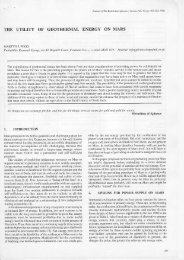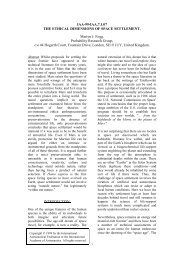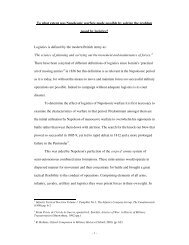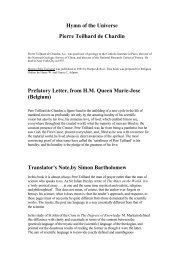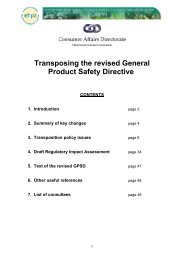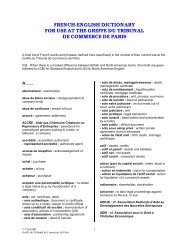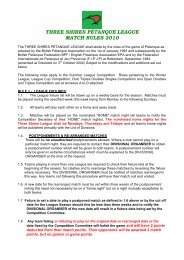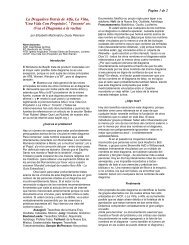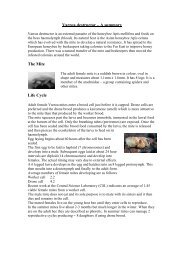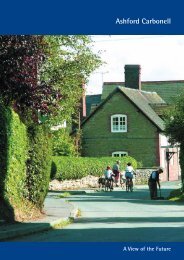Tibetan Herbal Medicine Core Curriculum [PDF]
Tibetan Herbal Medicine Core Curriculum [PDF]
Tibetan Herbal Medicine Core Curriculum [PDF]
You also want an ePaper? Increase the reach of your titles
YUMPU automatically turns print PDFs into web optimized ePapers that Google loves.
This curriculum covers:<br />
• Aims<br />
• Outcomes<br />
• <strong>Curriculum</strong> content<br />
• Materia Medica<br />
• Pharmaceutical and Clinical Training<br />
• Means of Assessment<br />
• Allocation of Time<br />
• Indicative Reading<br />
Appendix 4:<br />
TIBETAN HERBAL MEDICINE<br />
CORE CURRICULUM<br />
Aims:<br />
The aim of qualification as a Practitioner of Traditional <strong>Tibetan</strong> <strong>Medicine</strong> (TTM) is to be<br />
someone who can :<br />
1. Practise with compassion and treat all patients equally.<br />
2. Maintain and establish respect and harmonious relations between fellow practitioners.<br />
3. Maintain an open mind and be willing to facilitate the exchange of knowledge between<br />
different health systems.<br />
4. Display an attitude of service to patients, which takes precedence over material gain.<br />
5. Practise continuous effort to gain further learning and experience as aids to professional<br />
growth.<br />
6. Display an appropriate theoretical knowledge and clinical competence through the study<br />
and mastery of the traditional mainstay of <strong>Tibetan</strong> medical studies, i.e. the compendium<br />
of instructions known as the rgyud bzhi or Fourfold Medical Treatise, taught through its<br />
major commentaries.<br />
7. Display great concern for the purity and efficacy of medicines, according to traditional<br />
<strong>Tibetan</strong> guidelines for recognising, selecting, gathering, drying, storing, purifying and<br />
processing the raw materials used to prepare the medicines and according to the<br />
regulations in force in this country and its accepted standards of good practice.<br />
8. Competently use pre-prepared or personally compounded formulae of the various<br />
materia medica to suit the patient's condition, in a way which removes or minimises any<br />
possible side effects and treats the patient as a whole, rather than treating just the<br />
presenting symptoms.<br />
9. Practise compassion, humility and the other noble human qualities outlined in the "Ethics<br />
and Behaviour" chapter of the rgyud bzhi in his or her service to others to eradicate the<br />
suffering of sentient beings, promote longevity and increase spiritual welfare.<br />
65
Outcomes:<br />
Upon completion of training, the Practitioner of Traditional <strong>Tibetan</strong> <strong>Medicine</strong> (TTM) shall be<br />
able to do the following.<br />
1. Offer diagnosis and treatment based upon the holistic approach of TTM, in<br />
which the mind and body are recognised as being interdependent.<br />
2. Offer diagnosis based upon visual and tactile observation and questioning, as follows.<br />
1. Visual observation is based upon a general appreciation of the patient's<br />
complexion, appearance and comportment, a brief examination of the eyes and ears,<br />
and a more detailed examination of the tongue and of a urine sample. Urine<br />
examination is further divided into eight sections<br />
a. Advice regarding procedures to be followed the night before urine<br />
examination.<br />
b. Time of examination.<br />
c. Appropriate container in which to check the urine of the patient.<br />
d. Changes of urine as it cools.<br />
e. How to recognise a healthy person’s urine.<br />
f. How to recognise a diseased person’s urine.<br />
g. How to recognise a dying person’s urine.<br />
h. How to recognise the urine of someone under severe mental disturbance.<br />
2. Tactile observation: takes the form of a general physical check and pulse reading.<br />
Pulse reading is divided into 13 sections, which the practitioner has to know –<br />
a) Procedures to be followed the night before reading.<br />
b) Correct time of pulse reading.<br />
c) Correct vessels for pulse reading.<br />
d) Extent of pressure applied by the fingers of the practitioner to read the pulse.<br />
e) How to read each specific type of pulse.<br />
f) How to distinguish the three "constitutional" pulse types.<br />
g) How to interpret the pulse according to the four seasons and the five elements.<br />
h) About the presence of "extraordinary pulses"<br />
i) How to distinguish between the various healthy and diseased pulses.<br />
j) How to distinguish between general and specific pulses.<br />
k) How to detect death pulses.<br />
l) How to detect the effect of severe mental disturbance in the pulse<br />
m) About the "lifespan pulses".<br />
3. Questioning means enquiring about the case history of the patient, as well as about<br />
signs, symptoms and the evolution of the illness presenting. The practitioner shall<br />
maintain and keep in confidence all records in relation to the patient.<br />
66
3. The Physician will be able to offer four areas of treatment to the patient:<br />
a) Advice on diet. The practitioner will advise the patient on diet according to each<br />
individual bodily constitution based on the nyes pa gsum 1 . All food and drink counselled<br />
should be based on the six primary tastes generated by the five elements and the three<br />
post-digestive effects. Advice is given to the patient on how to avoid incompatible foods<br />
and to consume food and drink in the right quantities.<br />
b) Advice on conduct. The practitioner will advise the patient on the ways in which one<br />
can live more healthily and to improve life expectancy. (S)he will also know the positive<br />
and negative influences exerted by being at odds or in harmony with family and society<br />
or with one's own or the more widely recognised moral values and will assess how, if at<br />
all, a patient can be tactfully and skilfully counselled so as to reduce the stress and illness<br />
that past and present behaviour may be causing.<br />
The practitioner should advise the patient on seasonal conduct and the relationship<br />
between the five internal elements and the five external elements, advising on correct<br />
behaviour according to the four seasons. The practitioner should advise on "occasional<br />
conduct" and the thirteen natural functions of the body, which should neither be overused<br />
or suppressed.<br />
c) Prescription of medicines. The practitioner has to take ten factors into consideration<br />
before prescribing medicine –<br />
1) analysis of which of the seven bodily constituents and three eliminating functions<br />
are affected<br />
2) geographic factors<br />
3) seasonal factors<br />
4) bodily constitution<br />
5) factors relating to age<br />
6) condition of the disease<br />
7) location of the disease<br />
8) metabolism of the patient<br />
9) strength of the patient<br />
10) eating habits of the patient<br />
The practitioner has to identify and know the taste, potency and post-digestive effect<br />
of each individual medicine and their ingredients in order for the medicine to be<br />
correctly prescribed.<br />
d) Other treatments, such as massage, herbal baths, application of warm herbal packs to<br />
critical points on the body etc., as outlined in the fourth section of the Fourfold Treatise<br />
(see below) and as appropriate according to the regulations on such treatments in place<br />
nationally.<br />
1<br />
This term refers to one of the fundamental principles of TTM, a field of study that is both vast and subtle. As<br />
there is nothing resembling this in modern allopathic medicine, it is impossible to find an adequate English<br />
translation and the westernised transcription of the <strong>Tibetan</strong> has been given here. A very approximate translation could<br />
give "agents" when they are in their healthy, unaltered state and pathologia when they have altered. (see OED) .<br />
67
4) The practitioner will promote preventive medicine. Most diseases are seen in TTM<br />
as originating from what are known as primary causes and secondary conditions. One<br />
should avoid reinforcing secondary conditions liable to bring the nyes pa gsum into<br />
imbalance. The practitioner has to advise the patient with regard to appropriate and<br />
moderate use of mind, body, speech and the five senses and encourage the patient to<br />
follow instructions on best diet and conduct.<br />
5) The practitioner should be able to bring, as far as is possible, the nyes pa gsum<br />
into balance by either lifestyle and diet counselling or by medication. The<br />
medication should not be excessive, deficient or inappropriate with respect to the nyes pa<br />
gsum.<br />
6) The practitioner has to clearly categorise diseases into easily curable, difficult to<br />
cure, rarely curable and incurable.<br />
7) The practitioner has to know the various signs of approaching death, according to<br />
the Fourfold Treatise categorisations of definite, indefinite, imminent etc.<br />
8) The practitioner will strive to care for the patient's welfare in an unbiased and<br />
open-minded way. Should his or her own skill, or TTM in general, be unable to cure the<br />
patient, the practitioner should recommend unhesitatingly a recourse to another system<br />
of treatment.<br />
68
<strong>Curriculum</strong> Content:<br />
The core curriculum laid out in this document is based upon the common ground of study in<br />
the major teaching institutions for <strong>Tibetan</strong> medicine in Dharamsala (India), Lhasa (<strong>Tibetan</strong><br />
Autonomous Region of China) and Xining (Quighai, China).<br />
What follows is a section-by-section description of the Fourfold Treatise, showing the main<br />
subjects studied during the four years. The Fourfold Treatise does not include training in rtsis<br />
(literally "calculations"), which traditionally existed as a training in its own right in Tibet and<br />
concerns a detailed study of all possible rhythms and movements in nature, including the<br />
human body. It is particularly concerned with the relation between the individual and the<br />
environment, studied through their mutual dependence and interaction, and is used, among<br />
other things, to determine the timing and suitability of treatments.<br />
Tibet was traditionally a very religious country. The physician, who strove to lead an<br />
exemplary moral and ethical life, enjoyed a highly respected status and often gave counsel.<br />
The making and giving of medicines was treated as a sacred task, as was most of the healing<br />
art. Traditional studies included a component of spiritual training, mainly concerned with the<br />
doctor's own moral and ethical values, the treatment of the patient and the preparation of<br />
medicines. As TTM training reaches a wider world, and people of other faiths or no faith wish<br />
to study its science, it is appropriate for a religious component to be offered as an option and<br />
not a requirement. However, the altruism, respect for others etc. which form part of the<br />
physician's ethical and moral training are an integral part of the core curriculum. 2<br />
2<br />
Eminent authorities, such as HH the Dalai Lama and Prof Khenpo Troru Tsenam in Lhasa, have insisted that<br />
TTM stands perfectly in its own right as a medical system without the Buddhist element and that the prayerful,<br />
religious component is an "added value" but not a necessity. Therefore making these an option rather than a<br />
requirement seems to pose no problem to the main holders of the traditions. The time devoted to these is not included<br />
in the study hours cited above.<br />
69
Overall Synopsis of the Fourfold Treatise:<br />
STRUCTURE<br />
The work consists of Four Treatises, divided into 156 chapters.<br />
4 Treatises :<br />
Subdivisions<br />
Chapters<br />
The Root treatise Six chapters 6<br />
The Explanatory treatise 11 points 31<br />
The Instruction treatise 15 sections 92<br />
The Final treatise 4 compendiums 27 (25+2 concluding)<br />
________<br />
156<br />
1 The root treatise<br />
This is a very condensed outline of the whole work which, when memorised, gives all the<br />
keys and instant access to the theory developed in the other parts.<br />
2 The explanatory treatise<br />
It provides the detailed explanation of the medical theory in 11 points.<br />
3 The instruction treatise<br />
Comprises the bulk of the work and presents the aetiology and modes of treatment of the<br />
various diseases.<br />
4 The final treatise<br />
It provides the theoretical background for the techniques of diagnosis, explains the<br />
different sorts of medicinal preparations and their processing and the various kinds of<br />
external treatments.<br />
70
DETAILED STRUCTURE AND SUBDIVISIONS OF THE 4 TREATISES<br />
THE 1ST TREATISE : 6 chapters<br />
Chap. 1 gleng gzhi Presentation of the circumstances of this teaching<br />
Chap. 2 gleng slong Exposition : overall synopsis of the 4 treatises<br />
Chap. 3 gzhi Normal physical condition viewed as the basis of illness<br />
Chap. 4 ngos 'dzin Diagnosis and symptoms of disorders<br />
Chap. 5 gso thabs Treatment, as diet, behaviour, medication and other therapies<br />
Chap. 6 rtsis kyi le'u The tree metaphor<br />
3 roots<br />
9 stems<br />
47 branches<br />
224 leaves<br />
_________________________________________________________<br />
THE 2ND TREATISE : Classified into 11 POINTS covering 31 chapters<br />
POINTS<br />
CHAPTERS<br />
1 bshad pa'i sdom Summary general outline of the work 1<br />
THE OBJECT OF TREATMENT<br />
point 2 : the body, point 3, illness.<br />
THE TREATMENT<br />
point 4 lifestyle, point 5 diet, point 6 medicines,<br />
point 7 external treatments.<br />
THE MEANS OF TREATMENT<br />
when in health : point 8 health preservation and longevity.<br />
when sick : point 9 diagnosis, point 10 methods and means of treatment.<br />
THE ONE WHO TREATS<br />
point 11 : the qualities required in a doctor.<br />
2 The body 2-7<br />
chags tshul Formation of the body (embryology)<br />
'dra dpe Metaphors for the body<br />
gnas lugs<br />
Nature of the body (quantitative anatomy dealing with the proportion<br />
of bodily constituents, nerves and blood vessels and<br />
other important channels in the body)<br />
lus kyi mtshan nyid Characteristics (physiology)<br />
dbye ba Types of physical constitutions<br />
'jig ltas Signs of death<br />
3 Illness 8-12<br />
(Aetiology )<br />
nad kyi rgyu Causes of illness 8<br />
nad kyi rkyen Contributing factors of illness 9<br />
nad 'jugs tshul Mode of inception of illness 10<br />
(Pathophysiology)<br />
nad kyi mtshan nyid Characteristics of illness 11<br />
nad kyi dbye ba Classification of diseases 12<br />
71
4 Behaviour 13-15<br />
rgyun spyod Usual behaviour<br />
dus spyod Seasonal behaviour<br />
gnas skabs spyod lam Occasional behaviour<br />
5 Diet 16-18<br />
zas tshul Survey of foods and their nutritional value<br />
zas sdom pa Dietary restrictions<br />
zad tshod ran pa The right amount of food and drink to ingest<br />
6 <strong>Medicine</strong>s 19-<br />
21<br />
sman gyi ro “Taste” and “post-digestive taste” 19<br />
sman gyi nus pa<br />
This chapter outlines the theory of the six basic “tastes” and<br />
eight fundamental “potencies” which give each substance its own<br />
properties. This is the basis for compounding medicines in order<br />
to achieve the desired curative effect.<br />
20a<br />
“Intrinsic potency” : the Materia Medica 3<br />
20b<br />
The actual Treatise gives a basic list of over 300 products with their medicinal<br />
properties,also the much larger pharmacopoeia of TTM is also studied in famous<br />
commentaries such as Shel gong (Crystal Mirror) and Shel ‘phreng (Crystal rosary)<br />
sman gyi sbyar thabs<br />
The compounding of medicines (principles)<br />
21<br />
7 Instruments (used in external treatments) 22<br />
cha byad<br />
Surgical and medical instruments<br />
8 Health preservation 23<br />
mi na gnas Remaining healthy (preventive medicine)<br />
9 Diagnosis 24-26<br />
nyes pa dngos ston Diagnosing the actual condition of the patient<br />
ngan gyo skyon brtag Diagnosing by indirect questioning: gaining the patient's<br />
confidence<br />
spang blang ma bzhi Four criteria to investigate whether a disease can be treated or<br />
not<br />
10 Treatment of illness 27-<br />
30<br />
gso tshul spyi<br />
khyad par gso thabs<br />
gso thabs gnyis<br />
gso thabs dngos<br />
General method of treatment<br />
Specific methods of treatment<br />
Common means of treatment<br />
Specific means of treatment<br />
3<br />
see list of principal herbs (not exhaustive) used in Materia Medica section below<br />
72
11 The doctor's qualities<br />
31<br />
gso ba po sman pa This outlines the professional qualities<br />
and ethical standards required of a doctor<br />
___________________________________________________<br />
THE 3RD TREATISE :<br />
Classified into 15 sections covering 92 chapters<br />
NOTE : Please, consider the following English translations of diseases as<br />
PROVISIONAL. 4<br />
CHAPTERS<br />
Request for the teaching 1<br />
SECTION 1 “DISRUPTION OF THE THREE Nyes pa”<br />
Rlung disorders - diagnosis and treatment 5 2<br />
Mkhris pa disorders - diagnosis and treatment 3<br />
Bad kan disorders - diagnosis and treatment 4<br />
'dus nad Combination of all threediagnosis<br />
and treatment 5<br />
SECTION 2 "COLD" DISEASES (“CONSUMPTIVE” DISORDERS)<br />
ma zhu ba Digestive problems 6<br />
skran Tumours 7<br />
skya rbab Oedema, 1st stage 8<br />
'or Oedema, second stage 9<br />
dmu chu Oedema, advanced stage 10<br />
gchong chen Chronic metabolic disorder resulting in wasting of<br />
zad byed bodily constituents 11<br />
SECTION 3 "HOT" DISEASES (FEVERS, INFLAMMATIONS, INFECTIOUS<br />
DISEASES)<br />
tsha ba spyi Survey of hot disorders in general 12<br />
gal mdo Clarification of possible errors about<br />
4<br />
Much long term research is required to ascertain the exact nature of each illness<br />
categorised in the <strong>Tibetan</strong> medical system in order to find equivalences in the Western medical<br />
classification wherever possible, and to establish the right terminology. This work is presently<br />
underway. At this early stage, tentative equivalents are sometimes given in brackets as indications,<br />
without certainty.<br />
5<br />
(See the Note on Principles of TTM and terminology). This section shows disorders caused<br />
by the disruption of each one of the three Nyes Pa . These can be viewed as key pathologies since<br />
all illnesses are due to a disturbance of the basic balance between the three agents which make up<br />
the body and ensure the functioning of all body systems.<br />
73
hot and cold diseases 13<br />
ri thang "Borderline situations" (“Nyes pa” reactions<br />
mtshams following the treatment of a fever) 14<br />
ma smin tsha ba Immature fever 15<br />
rgyas tshad Fully-developed fever 16<br />
stongs tshad Empty fever 17<br />
gab tshad Hidden or latent fever 18<br />
rnying tshad "Old" fever (chronic) 19<br />
rnyogs tshad "Turbid" fever 20<br />
'gram tshad Post-traumatic fever 21<br />
'khrugs tshad “Disturbing” fever 22<br />
rims tshad Contagious diseases 23<br />
'brum pa Pox-type diseases (smallpox etc..) 24<br />
rgyu gzer Infectious dis. of intestines 25<br />
gag lhog<br />
Infectious dis. of throat<br />
and of muscle tissues (could include diptheria) 26<br />
cham pa Common cold and influenza 27<br />
SECTION 4 DISEASES OF THE UPPER PART OF THE BODY<br />
mgo nad Head 28<br />
mig nad Eyes 29<br />
rna nad Ears 30<br />
sna nad Nose 31<br />
kha nad Mouth 32<br />
lba ba Goitre and throat diseases 33<br />
SECTION 5 VISCERAL DISEASES<br />
snying nad Heart 34<br />
glo nad Lungs 35<br />
mchin nad Liver 36<br />
mcher nad Spleen 37<br />
mkhal nad Kidneys 38<br />
pho ba' nad Stomach 39<br />
rgyu ma'i nad Small intestine 40<br />
long nad Large intestine 41<br />
SECTION 6 SEXUAL DISEASES<br />
pho mtshan nad Male genital disorders 42*<br />
mo mtshan nad Female genital disorders 43*<br />
SECTION 7 MISCELLANEOUS DISEASES<br />
skad 'gags Problems of voice production 44<br />
yi ga 'chus pa Loss of appetite (all forms) 45<br />
skom dad Intense chronic thirst 46<br />
skyigs bu Hiccups 47<br />
dbugs mi de Breathing difficulties (all forms, can include<br />
asthma) 48<br />
glangs thabs Sharp abdominal pains of infectious<br />
origin (includes colic) 49<br />
srin nad Infections/inflammations (micro-organisms normally<br />
present in the body become pathogenic) 50<br />
skyugs Vomiting 51<br />
'khru nad Diarrhoea 52<br />
dri ma 'gag Constipation 53<br />
gchin 'gags Urinary retention 54<br />
74
(12 different sorts of disorders : partial or<br />
total retention, reduced amount of urine,<br />
with or without pain and inflammation, etc..)<br />
* Notifiable diseases will be reported to Department of Public<br />
Health.<br />
gchin snyi Polyuria 55<br />
(20 sorts of disorders : excessive production<br />
of urine, with or without inflammation of<br />
urethra, possible presence of pus, blood,<br />
sperm, etc... includes diabetes)<br />
tshad 'khru Infectious diarrhoea 56<br />
dreg Gout 57<br />
grum bu Rheumatic diseases (osteoarthritis) 58<br />
chu ser nad “Chu-Ser” disorders 59<br />
(Skin affections of various sorts due to serous<br />
fluid dysfunction; also includes a pathology<br />
close to rheumatoid arthritis)<br />
rtsa dkar nad Neurological disorders 60<br />
pags nad Dermatological diseases 61<br />
phran bu'i nad Miscellaneous minor<br />
disorders<br />
SECTION 8 "ENDOGENOUS SORES/SWELLINGS"<br />
'bras nad Swellings, tumours 63<br />
(Also various kinds of cysts and growths)<br />
gzhang 'brum Haemmorrhoids 64<br />
me dbal "Fire tongues" : 65<br />
(Burn-like blisters, mostly on the skin<br />
but can also be internal .. could include erysipelas)<br />
sur ya “Surya” swellings : 66<br />
Blood clots obstruct the lumen of vessels supplying the<br />
lungs, the liver, the kidneys, the stomach or the large<br />
intestine, and this causes swelling around the affected<br />
organ.<br />
75
men bu'i nad Swelling of glands 67<br />
rligs rlugs Swelling of scrotum and testicles 68<br />
rkang 'bam Swelling of lower limbs 69<br />
mstan bar rdol Anal fistula (possibly) 70<br />
SECTION 9 CHILDREN'S DISEASES (PEDIATRICS)<br />
byis pa nyer spyod Child care 71<br />
byis nad Children's diseases 72<br />
byis pa'i gdon Disturbances in children caused by negative 73<br />
influences in their environment<br />
SECTION 10 WOMEN'S DISEASES (GYNEACOLOGY)<br />
mo nad spyi General disorders 74<br />
mo nad bye brag Specific disorders 75<br />
mo nad phal ba Common disorders 76<br />
SECTION 11 DISORDERS DUE TO "MALEVOLENT INFLUENCES”<br />
(NEUROLOGY AND PSYCHIATRY)<br />
This section presents a mixture of disorders : some that are mostly of a neurological<br />
nature, with or without some degree of mental illness, and some which correspond to<br />
various forms of mental illness. The person believed themselves to be under malevolent<br />
forces, as was often the case at the time (demons, elementals, etc..) Each chapter<br />
outlines specific physiological and behavioural symptoms, diagnosis and treatment. Every<br />
practitioner was exposed to Buddhist philosophy and psychology ;this clearly demarcates<br />
the view that perception depends on the observer and there is no “objective reality”.<br />
Instead the practitioner would have considered patients disturbed who insisted on seeing<br />
themselves to be under demonic or other malign influence (as is the case with paranoid<br />
patients in the modern world, although it may take on a modern tinge, for example<br />
having electric shocks sent through the body). These perceptions of demonic influences<br />
would have been consistent with local folk understanding. Patients exhibiting such<br />
thinking were seen to be the influence of negative emotional states on the mind (i.e. to<br />
poison the mind stream). Buddhism sees thought, emotions and biophysical aspects of<br />
the mind as inseparable. Emotions such as jealousy and rage were seen to unbalance<br />
and disturb the mind, at all levels be this thinking, feeling or indeed in its physical<br />
manifestation. From a Buddhist perspective such emotions arise from an ego centred<br />
approach to the world. Belief in an independent ego was seen as a conceptual<br />
misunderstanding, which was seen to underlie such negative emotional states of mind.<br />
The ego and its demand for gratification was described as the “ultimate demon”. Training<br />
practitioners of <strong>Tibetan</strong> <strong>Medicine</strong>, in Tibet, would have been exposed to such teachings.<br />
For example in commentary by Patrul Rinpoche, a famous meditation master of the XIX<br />
Century in Tibet:<br />
“ “The many spirits”means concepts,<br />
“the powerful spirit”means belief in a self.”<br />
Again Milarepa (1052-1135), one of the founding fathers of Buddhism in Tibet:<br />
“Take a demon as a demon and it will harm you;<br />
Annex I: Page 76
take a demon as your own mind and you’ll be free of it.” ∗<br />
byungs po'i nad “Elementals’ influence ” 77<br />
Various patterns of mental disturbance accompanied<br />
by physiological manifestations and erratic<br />
behaviour, possibly referring to mood,psychotic disorders etc.<br />
smyo “Insanity-makers” 78<br />
Physical signs and disturbed behaviour akin<br />
to bipolar affective disorders<br />
brjed “Making one forget” 79<br />
Neurological disorder possibly akin to dementia.<br />
gza' “Planetary influence” 80<br />
Neurological disorders - include strokes leading to hemiplegia<br />
and/or epilepsy<br />
klu gdon nad “Naga influence” 81<br />
This relates mostly to the leprosy.<br />
SECTION 12 WOUNDS, INJURIES<br />
rma spyi General 82<br />
mgo'i rma Head wounds 83<br />
ske'i ma Neck wounds 84<br />
byang khog ma Abdominal wounds 85<br />
yan lag rma Limb wounds 86<br />
SECTION 13 POISONS<br />
sbyar dug Specially formulated poisons 87<br />
gyur dug Food poisoning 88<br />
dngos dug Natural poisons 89<br />
SECTION 14 GERIATRICS<br />
bcud len Revitalisation treatment 90<br />
SECTION 15 VIRILITY/FERTILITY TREATMENT<br />
ro tsa Virility 91<br />
bu med btsal Woman's fertility treatment 92<br />
__________________________________________________________________<br />
∗ Words of My Perfect Teacher by Patrul Rinpoche translated by Padmakara Transaltion Committee Harper<br />
Collins 1994<br />
Annex I: Page 77
Annex I: Page 78
THE 4TH TREATISE (known also as the 4 compendiums : pulse, urine, medicinal<br />
treatment, external treatment)<br />
27 chapters<br />
1 Diagnosis CHAPTERS<br />
Through examination of pulse and urine<br />
rtsa Pulse 1<br />
chu Urine 2<br />
2 “Calming” medicinal treatment<br />
thang decoctions 3<br />
phye ma powders 4<br />
ril bu pills 5<br />
lde gu pastes 6<br />
sman mar medicinal butters 7<br />
thal sman "calcinates" 8<br />
khanda extracts 9<br />
sman chang medicinal brews 10<br />
rin po che preparations based on precious stones<br />
or substances 11<br />
sngo sbyor herbal preparations 12<br />
3 “Cleansing” medicinal treatment<br />
Preparation for the 5 “Works” :<br />
snum 'chos Lubrication (oil therapy) 13<br />
The Five Works :<br />
bshal 1 purgatives 14<br />
skugs 2 emetics 15<br />
sna sman 3 cleansing via the nose 16<br />
'jam rtsi 4 gentle enema 17<br />
ni ru ha 5 forceful enema 18<br />
Extra-powerful supplement to the 5 “Works” :<br />
rtsa sbyong “channel” cleansing 19<br />
4 Gentle and forceful external treatments<br />
gtar 1 bloodletting 20*<br />
bsreg 2 moxibustion 21*<br />
dugs 3 hot/cold applications 22<br />
lums 4 baths/steam baths 23<br />
byug pa 5 ointments 24<br />
Extra-powerful supplement to the 5 external treatments :<br />
thur dpyad minor surgery 25*<br />
mjug don + yongs gtad<br />
+ 2 extra chapters of conclusion and entrustment 26,27<br />
* These would not be practiced in any country where the law forbids TM practitioners<br />
from undertaking such procedures or where they would be precluded by cultural<br />
constraints.<br />
Annex I: Page 79
MATERIA MEDICA<br />
Materia medica<br />
The traditional <strong>Tibetan</strong> materia medica contained certain ingredients which, at the time of<br />
writing, are not allowed under current UK law or under international convention 6 . This<br />
includes the use of certain toxic herbs and the use of mineral and animal ingredients. The<br />
curriculum is tailored to meet UK legal requirements and therefore covers only the herbal<br />
part of the traditional materia medica. The most common herbal components of TTM are<br />
listed (not exhaustive) below. Research is required to finalise identification of the Latin<br />
recognitions. The following are offered as current identifications.<br />
<strong>Tibetan</strong><br />
Transliteration<br />
Latin<br />
Recognition<br />
<strong>Tibetan</strong><br />
Transliteration<br />
Latin<br />
Recognition<br />
ka ko la Amomum tsao-ko 'bra go Phoenix<br />
dactylifera<br />
skyu ru ra Phyllantus emblica brag lcam Sedum<br />
tartarinowii<br />
ka randza Caesalpinia crst L. drag spos Lepisorus<br />
soulieanus<br />
ku shu Malus sp. brag lcam 2 Bergenia ciliata<br />
skyi 'brum Sophora Davidii brag skya ha bo Corralodiscus<br />
kingianus<br />
ka bed Curcurbita pepo 'bam po Pleurospermum<br />
skyer me<br />
Berberis jamesiana<br />
(flower)<br />
bya pho tsi<br />
Ceratostigma<br />
griffithii C.B.<br />
Clarke<br />
Arctium lappa<br />
kanda ka ri<br />
Rubus niveus<br />
Thumb.<br />
byi bzung<br />
skyer ba Berberis wood 'bri mog Onosma hoolerii<br />
klung sho Rumex nepalensis bre ga Thlaspi arvense<br />
kon pa gab skyes Saussurea bodiueri bya rgod spos Delphinium<br />
chrysostrichum<br />
ku sha Poa sp. 'bu su hang Medicago<br />
archiducis<br />
kyi lce dkar nag<br />
Gentiana<br />
straminea Marin<br />
(light form) and G.<br />
crassicaulis Duthie<br />
ex Burkill (dark<br />
form)<br />
byi shang dkar mo<br />
Stellaria<br />
yunnanensis<br />
ske tshe Sinapsis sp. bya rog nyung ma Lancea tibetica<br />
Hook<br />
mkhal zho Canavalia Gladiata byi rug Elscholtzia<br />
calyocarpa Diels<br />
kham bu Prunus sp. 'bri ta sa 'dzin Lagotis<br />
brachystachya<br />
khyi shing 'bri ta sa 'dzin 2 Fragaria<br />
6<br />
Affected by the Convention on International Trade in Endangered Species, allowed if traded with the<br />
appropriate trade permits OR non-plant materials as, under UK law, non-plant traditional medicines fall outside<br />
the remit of the licensing exemption granted to herbs by the 1968 <strong>Medicine</strong>s Act OR restricted under SI 2130<br />
Schedule 111, 1974 OR banned for use in unlicensed medicines by Act of Parliament.<br />
Annex I: Page 80
orientalis<br />
khyung sder dkar Uncaria scandens byi'u la phug Torularia humilis<br />
po<br />
(Smith) Hutch<br />
khyung sder smug<br />
po<br />
Saussurea stella<br />
Manim<br />
bya rgod spos Delphinium<br />
brunonianum<br />
'khan pa<br />
Artemisi<br />
sieversiana<br />
brag sgog<br />
Allium sativum<br />
(wild)<br />
khrog chung ba Lepidium apetalum<br />
Willd.<br />
bya rgod sug pa Anemone<br />
trullifolia<br />
khu byug pa Cypripedium byi'u srad<br />
Polygala sibirica<br />
tibeticum<br />
khur mong<br />
Taraxacum<br />
tibeticum<br />
ma ru rtse<br />
Butea<br />
monosperma<br />
srog shing Smag Metroxylum sago<br />
ga bur<br />
tiger<br />
ma gal<br />
Populus daviana<br />
camphor=blumea<br />
balsamifera and<br />
crystal<br />
camphor=cinnamo<br />
mum camphorum<br />
gur gum Crocus sativus mon cha ra Quercus (acorns)<br />
go bye<br />
Semiecarpus<br />
anacardius L.<br />
ma nu<br />
Inula racemosa<br />
Hook<br />
rgun 'brum Vitis vinifera sman sga Alpinia officinalis<br />
rgya shug 'bras bu Juniperus<br />
me tog ser chen Ixeris sp.<br />
formosana Hayata<br />
ge sar gsum Bombas<br />
malabaricum:<br />
smug chung 'den<br />
yon<br />
Meconopsis<br />
henricii<br />
1. stamen 2.<br />
calyx 3. corolla<br />
sgron shing<br />
Pinus<br />
myong tsi spras Coptis teetoides<br />
tabulaeformis, but<br />
also P.<br />
massoniana, P.<br />
yunnanensis, P.<br />
densata, P.<br />
griffithii, P.<br />
smithiana, P.<br />
armandi<br />
ga bra<br />
Rubus subomatus<br />
and other Rubus<br />
tsam pa ka<br />
Oroxylum<br />
indicum<br />
glang ma Salix thompsoni tsan dan Santalum album<br />
gu gul<br />
Commiphora<br />
mukul<br />
tsi tra ka<br />
Capsicum<br />
frutescens<br />
rgya skyegs Lacifer lacca Kerr Btsod Rubia cordifolia<br />
gur tig Rtsad Pleurospermum<br />
sp.<br />
sga skya<br />
Zingiber officinalis<br />
Rose<br />
rtsa mkhris<br />
Saussurea<br />
graminea<br />
dgu thub/rgu thub Peucedanum btsong sgog Allium cepa<br />
praeruptorum<br />
Dunn.<br />
gres ma<br />
Iris nepalensis<br />
(anthers)<br />
mtshe ldum<br />
Ephedra<br />
equisetina<br />
rgya sho Rumex crispus L. tsar bong Artemisia<br />
desertorum<br />
Annex I: Page 81
sga chung tsher sngon Meconopsis<br />
horridula<br />
ga dur<br />
Bergenia<br />
purpurascens<br />
dza ti<br />
Myristica<br />
ficafragrans<br />
(Hook f et Thoms)<br />
gla sgang Cyperus scariosus mdzo mo shing Caragana<br />
tibetica<br />
gro ma Potentilla fulgens zhu mkhan Skimia<br />
multinerva<br />
gang ga chung Gentiana urnula zhim thig le 1 Lagopsis supina<br />
[Steph]<br />
sga tsha zhim thig le 2 Phlomis<br />
betonicoides<br />
Diols<br />
rgya men Papaver sp. zhim thig le 3 Salvia<br />
roborowskii<br />
glang sna<br />
Pedicularis<br />
longiflora<br />
zhim thig le 4 Nepeta<br />
coerusens<br />
sga tig<br />
Androsace aizoon zhim thig le 5 Stachys. sp<br />
Duly var. coccinea<br />
Franch.<br />
go snyod Carum carvi zhim thig le 6 Galeopsis bifida<br />
Boenn.<br />
sgang thog pa<br />
Sisymbrium<br />
heteromallum<br />
zhim thig le 7<br />
Stachys<br />
kouyangensis<br />
(Vaniot)<br />
Lamium<br />
amphexicaule<br />
sga sho<br />
Cremanthodium<br />
sp.<br />
zhim thig le 8<br />
ga bur tis lo zhim thig le 9 Salvia wardii<br />
gandha bhadra Cnaphalium affine zla gor zho sha Entada<br />
phaseoloides<br />
rgya spos<br />
Delphinium<br />
zangs tig<br />
Swertai mussofi<br />
chysotrichum<br />
rgu drus<br />
Corydalis<br />
dasyptera<br />
gze ma<br />
Tribulus<br />
terrestris<br />
sgog skya Alium sativum zva' 'drum Urtica<br />
triangularis<br />
rgya sgog<br />
Alium sativum zva phyi A yas Urtica tibetica<br />
(lower altitude)<br />
gla ba srad ma Hedysarum zir dkar Cuminum<br />
cymnum<br />
dngul tig Cerastium arvense zir nag Nigella<br />
glandulifera<br />
sngon bu Cyananthus sherifii zangs rtsi dkar Galium aparin<br />
dngul sha ma zangs rtsi nag Artemisia hedinii<br />
smug cu gang Schizostachyum zin tig<br />
Ajuga lupulina<br />
chinense<br />
lcang ma Salix sp. gza' dug Saussurea<br />
obvallata<br />
lcags tig<br />
Gentianopsis 'o se<br />
Pyrus pashia<br />
grandis<br />
lca ba Angelica sinensis 'om bu Myricaria<br />
garmanica<br />
lcam pa Malva verticillata 'u su Coriandrum<br />
sativum<br />
lcum rtsa Rheum officinale 'od ldan Saxifraga<br />
Annex I: Page 82
Baill.<br />
egregia<br />
lcags kyu Corydalis sp. 'ol mo se Sinopodophyllum<br />
hexandrum<br />
mchin pa zho sha Entada scandens gyer ma Scrophularia<br />
dentata<br />
chu rtsa<br />
Rheum spiciforme yo 'bog<br />
Ulmus<br />
Royle<br />
chu ma rtsi 1 Rheum pumilum yung ba<br />
Curcuma longa<br />
Maxim<br />
chu ma rtsi 2 Polygonum<br />
hookeiri Moisn.<br />
yu gu shing<br />
Senecio<br />
soliagineous<br />
chu sho Acalypha australis gyer shing pa Schrophularia<br />
dentata<br />
chu rug<br />
Cardamine<br />
macraphylla Willd.<br />
yog mo<br />
Rabdosia<br />
rubescens<br />
'jam 'bras<br />
Caesalpina crista<br />
L.<br />
gya' kyi ma<br />
Chrysoplenium<br />
carnosum Hook<br />
ja shing gyar mo thang Primula<br />
fasciculata<br />
'jib chen<br />
Dracocephalum<br />
heterophyllum<br />
yu mo 'de'u 'byin Paraquilegia<br />
microphya<br />
Benth.<br />
'jib chen 2<br />
Salvia Przewalskii<br />
Maxim.<br />
ru rta<br />
Vladmiri souliei<br />
snying zho sha<br />
Choerospondia<br />
axillaris (Roxb.)<br />
Burtett Hill<br />
ra mnye<br />
Polygonatum<br />
cyrrhifolia<br />
nye shing Asparagus filicinus re lcag Stellera<br />
chamaejasmae<br />
snya lo<br />
Polygonum<br />
polystachium<br />
ri sho<br />
Ligularia<br />
vigaurea<br />
gnyan 'dul ba re skon Corydalis<br />
hendersonii<br />
gnyan thub pa ram bu Polygonum<br />
viviparum<br />
snyi ba<br />
Codonopsis<br />
convulvlacae<br />
ri sgog<br />
Allium<br />
atrosanguinium<br />
star bu<br />
Hippophae<br />
rug sgog<br />
Allium prattii<br />
rhamnoides<br />
star ga Juglans regia li shi Eugenica<br />
aromatica<br />
stag ma' me thog Rhododendron<br />
arboreum<br />
lung tang<br />
Sapindus<br />
mukorsii<br />
stabs seng<br />
Fraximus<br />
saureolans<br />
lug mur<br />
Phlomis<br />
younghusbandii<br />
tig ta Swerta chirayita lug sho Oxyria dygina<br />
tang ku<br />
Ledabouriella lug mig<br />
Aster himalyicus<br />
seseloides<br />
tang ku 2<br />
Sinolimprichtia<br />
alquina<br />
lug chung<br />
Heteropapus<br />
crenatifolius<br />
stang ri zil ba le brgen Targetes erecta<br />
stag sha<br />
Oxytropis<br />
chiliophylla<br />
la la phud<br />
Foeniculum<br />
vulgare<br />
til Sesamum indicum lug ngal Corydalis adunca<br />
rta rmig Viola biflora shug tsher Juniperus<br />
formosana<br />
Annex I: Page 83
ti mu sa Shing tsha Cinnamomum<br />
cassia<br />
rta lpags<br />
Lamiophlomis Shing kun<br />
Ferula asafoetida<br />
rotata<br />
thal rdor Cassia tora shel ta Pinus<br />
tabulaeformis<br />
(resin)<br />
thang khrag Abies spectabilis shu dag Acorus calamus<br />
thang phrom Przewalskia<br />
tangutica Maxim<br />
Shing mngar Gylcerrhiza<br />
uralensis<br />
tha ram Plantago depressa sho mang Rumex<br />
nepalensis<br />
dong ga Cassia fistula sha la yu ring Cremanthodium<br />
sp.<br />
dar shing<br />
Lepidium apetalum<br />
-wood<br />
Shang dril<br />
Primula<br />
sikkimensis<br />
da lis<br />
Rhododendrom shu ti<br />
Mentha arvense<br />
anthopodon<br />
re ral Dryanaria sinica shu mo za Trigonella<br />
foenum graecum<br />
dva ba Arisaema sp. shang tsher Orobanche<br />
alsatica<br />
dur byid<br />
Euphorbia<br />
fischeriana<br />
shang len smug po Eryophyton<br />
wallachii<br />
dur ba Cynodon dactylon sug smel Elettaria<br />
cardamomum<br />
'dam bu ka ra Catabrosa aquatica sra 'bras Syzgium cumini<br />
de ba<br />
Corydalis<br />
melanochlora<br />
so cha<br />
Randia<br />
dumetorum<br />
dug nyung<br />
Chamaeneriom<br />
angustifolium<br />
so ra<br />
Abelmoschu<br />
moschatus<br />
'dre sha ma Lycium chinense se yab Chaenomeles<br />
speciosa<br />
ldum nag se 'bru Punica granatum<br />
(seeds only)<br />
dar ya kan Lepidium apetalum se rgod Rosa sertata<br />
dug srad Astralagus strictus srin shing Daphne<br />
tangutica<br />
na le sham Piper nigrum seng ldeng Rhamnella<br />
gilgitica<br />
nim pa Azedirachta indica sle tres Tinospoa<br />
sinensis<br />
nags ma' thang chu gser tig Saxifraga<br />
montana<br />
na rams<br />
Triglochia<br />
maritimum<br />
su mi<br />
Corydalis<br />
yanhusuo<br />
nad ma<br />
Cynoglossum<br />
wallichii<br />
sro lo<br />
Pegaeophyton<br />
scapiflorum<br />
sne'u 1<br />
Chenopodium<br />
album<br />
sug pa<br />
Solms-Laubachia<br />
earycarpia<br />
sne'u 2<br />
Amaranthus<br />
caudatus<br />
gser me<br />
Herpetospermum<br />
pendiculosum<br />
pi pi ling Piper longum gser phud Luffa cylindrica<br />
spa 'brum sog ka Capsella bursa<br />
pastoris<br />
spen dkar Potentilla glabra srub ka Anemone<br />
Annex I: Page 84
ivularis<br />
pushkar mu la Inula racemosa srad ma rigs Astralagus sp.<br />
Spyang tsher Morina kokonorika seng ge 'jigs med Silene sp.<br />
Hao<br />
spru ma<br />
Heracleum<br />
wallachii<br />
hong len<br />
Lagetis<br />
yunnanensis<br />
Spyang dug pa Cirsium souliei A ru ra Terminalia<br />
chebula<br />
dpa' bo dkar po Phytolacca acinosa A 'bras<br />
Mangifera indica<br />
esculenta<br />
dpa' ser<br />
Phytolacca acinosa A ga ru<br />
Aquilaria sinensis<br />
Roxb.<br />
dpa' rgod Curcuma zedoaria Ar nag Aquilaria<br />
agallocha<br />
dpa' bo chen po Panax ginseng C A<br />
May<br />
A sho<br />
Mirabilis<br />
himalaica<br />
pu shel Dendrobium nobile A krong Thalictrum<br />
aquilegifolium<br />
Loeog<br />
par pa ta<br />
Hypecoum<br />
leptocarpum<br />
A krong 2<br />
Arenaria<br />
Kansuensis<br />
Maxim<br />
Spang rgyan dkar Gentiana<br />
A wa<br />
Lloydia<br />
szechenyii<br />
Spang rgyan dkar<br />
2<br />
Gentiana algida Autpal Meconopsis<br />
torquata<br />
Spang rgyan sngon<br />
po<br />
Gentiana stipitata A byag Chrysanthemum<br />
tatsiniensis<br />
Spang rgyan nag<br />
po<br />
Gentiana<br />
veitchiorum<br />
Aug chos<br />
Incarvillia<br />
compacta<br />
pad rtsa<br />
Nelumbo nucifera<br />
Gaertn<br />
A bhi kha<br />
Fritillaria<br />
delavayi<br />
pri yang ku<br />
Dracocephalum<br />
tanguticum<br />
ba sha ka<br />
Corydalis<br />
impatiens<br />
spra thog<br />
Leontopodium<br />
franchetii<br />
bra ma<br />
Caragana<br />
brevifolia<br />
Spang rtsi<br />
Pterocephalus<br />
hookerii<br />
dbyi mong<br />
Clematis<br />
rhederianum<br />
spa yag Lancia tibetica byis tsher Xanthium<br />
sibericum<br />
pa to la Bletilla striata ba lu Rhododendron<br />
primulaeflora<br />
Spor Sedum sp. 'brug shing Euonymas<br />
monbeigii<br />
phur mong Artemisia nestita bo te Prunus sp.<br />
beedurya 'dra Saussurea<br />
byi tang ka<br />
Embelia laeta<br />
hieraciodes<br />
ba ru ra<br />
Terminalia<br />
bellerica<br />
PHARMACY AND CLINICAL TRAINING<br />
Annex I: Page 85
Pharmacy and Clinical training are covered in separate modules in the EHPA core<br />
curriculum and will be provided in those contexts. Pharmacy training will prepare the<br />
student to recognise the various materia medica, understand the different qualities of<br />
plants of the same species growing in different environments, know when materia<br />
medica are collected according to their destined purpose, how the materia medica are<br />
collected in order to best preserve their properties, how they are transported and stored,<br />
and understand the proper processing and preparation of the medicinal compounds<br />
according to the established rules and formulas. Traditional <strong>Tibetan</strong> Medical practitioners<br />
and manufacturers are aware of Good Manufacturing Practice and are moving swiftly to<br />
make GMP the standard for all herbal remedies used. They are similarly aware of the<br />
need to have Government certified GMP(CGMP), in manufacturing and importing<br />
businesses handling and manufacturing such remedies.<br />
Traditionally, TTM trainees would be immersed in a clinical environment throughout their<br />
training. In order to emulate this as far as possible, students are to be encouraged to use<br />
every opportunity to observe medical practice from the start.<br />
MEANS OF ASSESSMENT<br />
STUDY<br />
The principal means of assessment should be by written and oral examination.<br />
Educational institutions should endeavour to formulate these exams so as to prioritise<br />
understanding of principles, rather than simple memorisation. Nonetheless, it has been<br />
traditional to learn certain parts of the main rgyud bzhi text by heart, as the knowledge<br />
contained should be at the practitioner's fingertips at all times, being the very essence of<br />
the theory. In view of this, institutions should carefully consider the weighting to be<br />
given to this aspect.<br />
MATERIA MEDICA recognition and PHARMACY training<br />
This will be primarily subject to continued assessment during field trips and laboratory<br />
visits, with spot checks on field trips leading to points being subtracted from an overall<br />
total for wrong answers given. Written and oral examination on materia medica forms<br />
part of the general examination on study (above).<br />
CLINICAL PRACTICE<br />
Competence will be judged by continuous assessment by supervising physicians during<br />
clinical training. This will require the supervising physicians to maintain a record of<br />
diagnoses offered and treatment suggested by the student during clinical training. Not all<br />
cases need be recorded but should cases be selected, that selection must be made before<br />
the student is asked to diagnose and not in retrospect. At least 20% of the student's<br />
cases should be followed for assessment. Clinical examination will form part of the end of<br />
year and final examinations. This aspect of the assessment will be a critical factor<br />
determining the candidate's suitability to proceed to the next year or to qualify.<br />
ATTENDANCE<br />
Failure to attend more than 85% of classes will result in that term's study not being<br />
credited. Although this is the general rule, exemption may be made for sickness or other<br />
reasons, provided that the tutorial staff is satisfied that the missed ground has been<br />
adequately covered by the student.<br />
Annex I: Page 86
EXEMPTIONS<br />
Educational institutions should provide a coherent policy with regard to exemptions for<br />
prior learning. They must satisfy themselves that candidates who are exempted from<br />
parts of their curriculum have covered the required material and achieved required<br />
learning outcomes. Clear guidelines on this issue will be set out by the UK governing<br />
body on TTM, after consultation with the world's major TTM teaching institutions. The<br />
governing body will have the power to annul any granted exemption it deems unjustified.<br />
RECOMMENDED ALLOCATION OF TIME<br />
Following the recommendations for the common core curriculum presented elsewhere in<br />
this report, it is proposed that the total minimum course length should be 2560 hours, of<br />
which a minimum of one third should be teacher/student contact time. Within this total,<br />
it is proposed that a minimum of 1150 hours be devoted to <strong>Tibetan</strong> Traditional <strong>Medicine</strong><br />
(traditional physiology, pathology, diagnostic methods and study of the materia medica).<br />
In addition, a minimum of 450 hours of clinical practice is proposed.<br />
Annex I: Page 87
INDICATIVE READING<br />
DONDEN, Dr Yeshi "Health Through Balance, an Introduction to <strong>Tibetan</strong> <strong>Medicine</strong>"<br />
1986 Ithaca N. Y.; Snow Lion Publications<br />
FINCK, Dr Elisabeth<br />
"Studies in <strong>Tibetan</strong> <strong>Medicine</strong>" 1988 Ithaca; Snow Lion Publications<br />
MEYER, Prof. Fernand "Gso-ba rig-pa, le système médical tibétain. 1981, Paris C.N.R.S.<br />
RECHUNG RINPOCHE, Jampal Kunzang “<strong>Tibetan</strong> <strong>Medicine</strong>" 1973, Berkeley and Los<br />
Angeles, University of California Press.<br />
TSARONG, Dr T. J. "Fundamentals of <strong>Tibetan</strong> <strong>Medicine</strong>, according to the rGyud bzhi"<br />
Dharamsala, <strong>Tibetan</strong> Medical Centre<br />
VAN ALPHEN and ARIS "Oriental <strong>Medicine</strong>", chapters on <strong>Tibetan</strong> <strong>Medicine</strong>.London 1995.<br />
Serindia Publications.<br />
CLIFFORD,Terry “The Diamond Healing” <strong>Tibetan</strong> <strong>Medicine</strong> and Psychiatry.<br />
Annex I: Page 88


![Tibetan Herbal Medicine Core Curriculum [PDF]](https://img.yumpu.com/32594566/1/500x640/tibetan-herbal-medicine-core-curriculum-pdf.jpg)
